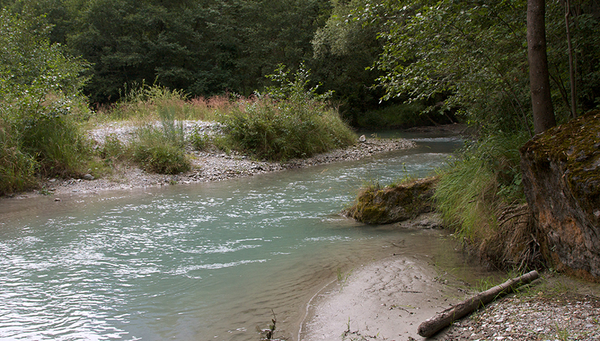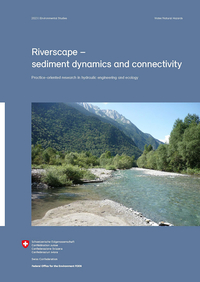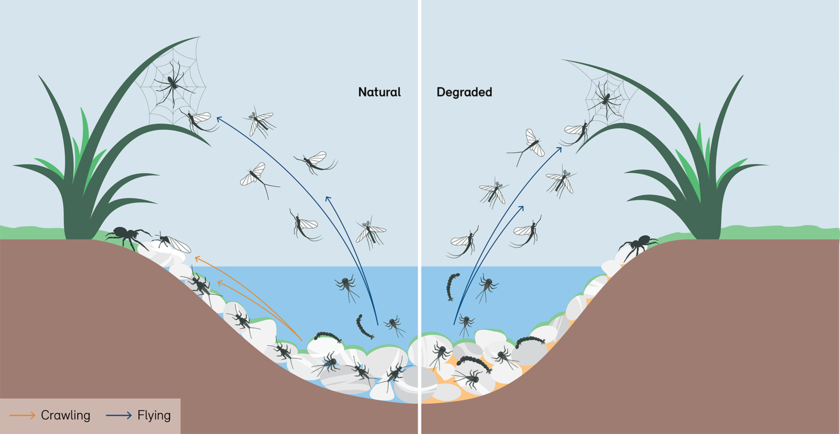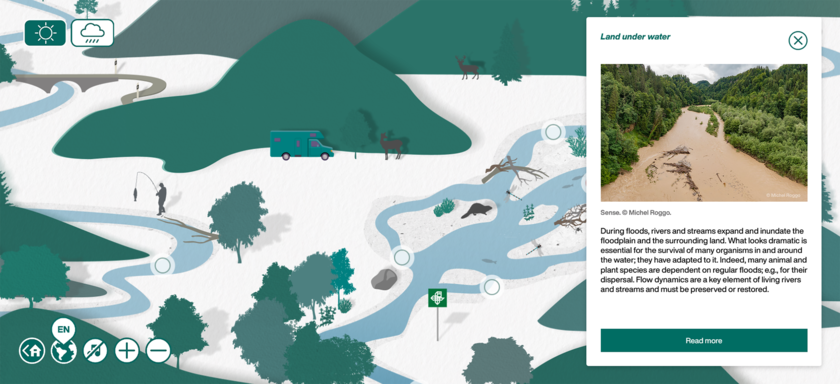News Detail
Addressing diversity with diversity: Interdisciplinary collaboration in the habitat mosaic of rivers
April 25, 2023 |
From very wet to very dry – near-natural riverscapes form a diverse mosaic of habitats inhabited by an above-average number of species. Just as diverse are the interests that come together in our densely used landscape during hydraulic engineering interventions such as flood protection or restoration projects. The interdisciplinary research project “Riverscape – Sediment Dynamics and Connectivity” as part of the research programme “Hydraulic Engineering and Ecology” therefore combines engineering and ecological perspectives in the study of diverse riverscapes. The results have now been prepared in several products for a diverse audience.
Reaching out to different stakeholders
A volume in the “Environmental Studies” (Umwelt-Wissen) series published by the Federal Office for the Environment (FOEN) clearly summarises the most important research findings. These are supplemented with contributions on implementation from experts in the field. An information flyer for a broad readership and the website www.rivermanagement.ch with an interactive map allow easy access to the diverse topics. Five short films complete the programme and illustrate the dynamic processes in watercourses.
It was important for the researchers to reach all people involved in water management. In particular, stakeholders without a specific professional background, for example in smaller municipalities, are not necessarily interested in the latest research details. Instead, they require an evaluation of the facts as well as an awareness of the key processes that need to be protected. “On the advice of our practice advisory group, we therefore decided in the project to also develop products for a broader audience for the first time,” explains project leader and ecologist Christine Weber for the aquatic research institute Eawag.
Connecting water and land
A total of 13 sub-projects were realised as part of the project “Riverscape”. A sub-project led by Chris Robinson from Eawag was dedicated to the interconnectedness of water and terrestrial ecosystems, which are closely linked in near-natural water bodies. Eawag doctoral student Carmen Kowarik investigated how human interventions influence the food web between land and water. Aquatic insects that spend their larval stage in the water are an important food source for lizards, birds and bats, as they are particularly nutritious compared to terrestrial insects because they contain valuable unsaturated fatty acids. Carmen Kowarik demonstrated in her work that hardly any stoneflies hatch in impaired bodies of water. Spiders that live on the ground near such shores and normally feed on the newly hatched stoneflies therefore have significantly fewer unsaturated fatty acids.
Flood protection for riverine organisms
In another sub-project, researchers from Eawag and the Laboratory of Hydraulics, Hydrology and Glaciology (VAW) at the ETH Zurich investigated how a specific type of restoration project – dynamic river widening – develops with a reduced supply of bedload. In many rivers in Switzerland, barriers or bank protection structures reduce the input of bedload. What does this mean for the organisms in the watercourses, especially during floods? Riverine organisms are dependent on refugia such as backwaters or side channels to protect themselves from the raging floods. In the joint studies, the researchers found that bedload supply plays a decisive role in determining the extent to which river widening can improve the supply of refugia and thus protect biodiversity.
During floods, backwaters or side channels provide important refugia for riverine organisms. Whether dynamic river widening improves the availability of such refugia essentially depends on bedload supply. (Excerpt from the interactive graphic at www.rivermanagement.ch)
Achieving more together
In the research project “Riverscape”, researchers from biology and the engineering sciences work closely together, crossing institutional and disciplinary boundaries. “Interdisciplinary collaboration is by no means a walk in the park,” project leader Christine Weber quotes a colleague with a laugh. “People speak different technical languages, use different methods and rarely work in the same institution.” Despite all the challenges, however, the researcher is still enthusiastic: “Interdisciplinary collaboration is enormously profitable, looking beyond one’s own horizon broadens your horizons and also sows seeds for your own disciplinary work!”
The Hydraulic Engineering and Ecology research programme
The Hydraulic Engineering and Ecology research programme develops scientific bases for current practical issues in watercourse management. Ecologists and hydraulic engineers from the four research institutions Eawag, PL-LCH EPFL, VAW ETH Zurich and WSL as well as the Federal Office for the Environment are participating in the research programme. Practitioners from the federal government, cantons, private offices, NGOs and associations support and advise the research work. The diverse collaborations enable a holistic view of our watercourses as biodiversity hotspots and flood retention areas.
Cover picture: The River Rhone in the Forest of Pfyn-Finges. (Photo: Michel Roggo).
Publications
Federal Office for the Environment, Publisher (2023). Riverscape – sediment dynamics and connectivity. Practice-oriented research in hydraulic engineering and ecology. Environmental Studies No 2302. Federal Office for the Environment FOEN, Bern.
Info-Flyer
Programme website «Hydraulic Engineering and Ecology»
Five short films illustrate the dynamic processes in watercourses
Funding / Cooperations
Research program "Hydraulic Engineering and Ecology" of FOEN, Eawag, VAW ETH Zurich, WSL and PL-LCH EPFL




